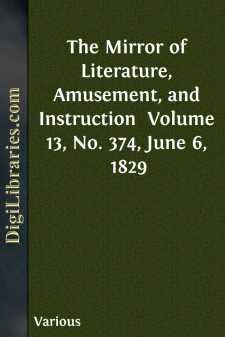Categories
- Antiques & Collectibles 13
- Architecture 36
- Art 48
- Bibles 22
- Biography & Autobiography 813
- Body, Mind & Spirit 142
- Business & Economics 28
- Children's Books 14
- Children's Fiction 11
- Computers 4
- Cooking 94
- Crafts & Hobbies 4
- Drama 346
- Education 46
- Family & Relationships 57
- Fiction 11829
- Games 19
- Gardening 17
- Health & Fitness 34
- History 1377
- House & Home 1
- Humor 147
- Juvenile Fiction 1873
- Juvenile Nonfiction 202
- Language Arts & Disciplines 88
- Law 16
- Literary Collections 686
- Literary Criticism 179
- Mathematics 13
- Medical 41
- Music 40
- Nature 179
- Non-Classifiable 1768
- Performing Arts 7
- Periodicals 1453
- Philosophy 64
- Photography 2
- Poetry 896
- Political Science 203
- Psychology 42
- Reference 154
- Religion 513
- Science 126
- Self-Help 84
- Social Science 81
- Sports & Recreation 34
- Study Aids 3
- Technology & Engineering 59
- Transportation 23
- Travel 463
- True Crime 29
The Mirror of Literature, Amusement, and Instruction Volume 13, No. 374, June 6, 1829
by: Various
Categories:
Description:
Excerpt
HOLLAND HOUSE, KENSINGTON.
Since the time of William III., who was the first royal tenant of the palace, Kensington has been a place of considerable interest, as the residence and resort of many celebrated men. The palace, however, possesses little historical attraction; but, among the mansions of the parish, Holland House merits especial notice.
Holland House takes its name from Henry Rich, Earl of Holland, and was built by his father-in-law, Sir Walter Cope, in the year 1607, of the architecture of which period it affords an excellent specimen. Its general form is that of an half H. The Earl of Holland greatly improved the house. The stone piers at the entrance of the court (over which are the arms of Rich, quartering Bouldry and impaling Cope) were designed by Inigo Jones. The internal decorations were by Francis Cleyne. One chamber, called the Gilt Room, which still remains in its original state, exhibits a very favourable specimen of the artist's abilities; the wainscot is in compartments, ornamented with cross crosslets and fleurs de-lis charges, in the arms of Rich and Cope, whose coats are introduced, entire, at the corner of the room, with a punning motto, alluding to the name of Rich, Ditior est qui se. Over the chimneys are some emblematical paintings, done (as the Earl of Orford observes) in a style and not unworthy of Parmegiane. The Earl of Holland was twice made a prisoner in his own house, first by King Charles, in 1633, upon occasion of his challenging Lord Weston; and a second time, by command of the parliament, after the unsuccessful issue of his attempt to restore the king, in August, 1648. The Earl, who was a conspicuous character during the whole of Charles's reign, and frequently in employments of considerable trust, appears to have been very wavering in his politics, and of an irritable disposition. In 1638, we find him retired to his house at Kensington, in disgust, because he was not made Lord Admiral. At the eve of the civil war, he was employed against the Scots; when the army was disbanded, having received some new cause of offence, he retired again to Kensington, where, according to Lord Clarendon, he was visited by all the disaffected members of parliament, who held frequent meetings at Holland House. Some time afterwards, when the civil war was at its height, he joined the king's party at Oxford; but, meeting with a cool reception, returned again to the parliament. In August 6, 1647, "the members of the parliament who were driven from Westminster by tumults, met General Fairfax at Holland House, and subscribed to the declaration of the army, and a further declaration, approving of and joining with the army, in all their late proceedings, making null all acts passed by the members since July 6." (Clarendon.)— The Earl of Holland's desertion of the royal cause, is to be attributed, perhaps, to his known enmity towards Lord Strafford; he gave, nevertheless, the best proof of his attachment to monarchy, by making a bold, though rash attempt, to restore his master....












